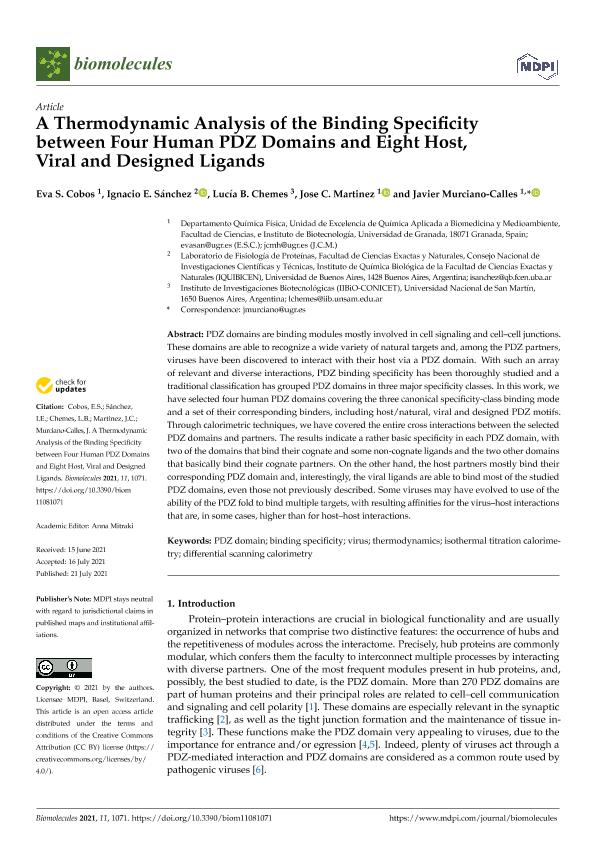Artículo
A thermodynamic analysis of the binding specificity between four human pdz domains and eight host, viral and designed ligands
Cobos, Eva S.; Sánchez Miguel, Ignacio Enrique ; Chemes, Lucia Beatriz
; Chemes, Lucia Beatriz ; Martinez, Jose C.; Murciano Calles, Javier
; Martinez, Jose C.; Murciano Calles, Javier
 ; Chemes, Lucia Beatriz
; Chemes, Lucia Beatriz ; Martinez, Jose C.; Murciano Calles, Javier
; Martinez, Jose C.; Murciano Calles, Javier
Fecha de publicación:
08/2021
Editorial:
MDPI AG
Revista:
Biomolecules
ISSN:
2218-273X
Idioma:
Inglés
Tipo de recurso:
Artículo publicado
Clasificación temática:
Resumen
PDZ domains are binding modules mostly involved in cell signaling and cell–cell junctions. These domains are able to recognize a wide variety of natural targets and, among the PDZ partners, viruses have been discovered to interact with their host via a PDZ domain. With such an array of relevant and diverse interactions, PDZ binding specificity has been thoroughly studied and a traditional classification has grouped PDZ domains in three major specificity classes. In this work, we have selected four human PDZ domains covering the three canonical specificity-class binding mode and a set of their corresponding binders, including host/natural, viral and designed PDZ motifs. Through calorimetric techniques, we have covered the entire cross interactions between the selected PDZ domains and partners. The results indicate a rather basic specificity in each PDZ domain, with two of the domains that bind their cognate and some non-cognate ligands and the two other domains that basically bind their cognate partners. On the other hand, the host partners mostly bind their corresponding PDZ domain and, interestingly, the viral ligands are able to bind most of the studied PDZ domains, even those not previously described. Some viruses may have evolved to use of the ability of the PDZ fold to bind multiple targets, with resulting affinities for the virus–host interactions that are, in some cases, higher than for host–host interactions.
Archivos asociados
Licencia
Identificadores
Colecciones
Articulos (IIBIO)
Articulos de INSTITUTO DE INVESTIGACIONES BIOTECNOLOGICAS
Articulos de INSTITUTO DE INVESTIGACIONES BIOTECNOLOGICAS
Articulos(IQUIBICEN)
Articulos de INSTITUTO DE QUIMICA BIOLOGICA DE LA FACULTAD DE CS. EXACTAS Y NATURALES
Articulos de INSTITUTO DE QUIMICA BIOLOGICA DE LA FACULTAD DE CS. EXACTAS Y NATURALES
Citación
Cobos, Eva S.; Sánchez Miguel, Ignacio Enrique; Chemes, Lucia Beatriz; Martinez, Jose C.; Murciano Calles, Javier; A thermodynamic analysis of the binding specificity between four human pdz domains and eight host, viral and designed ligands; MDPI AG; Biomolecules; 11; 8; 8-2021; 1-14
Compartir
Altmétricas



